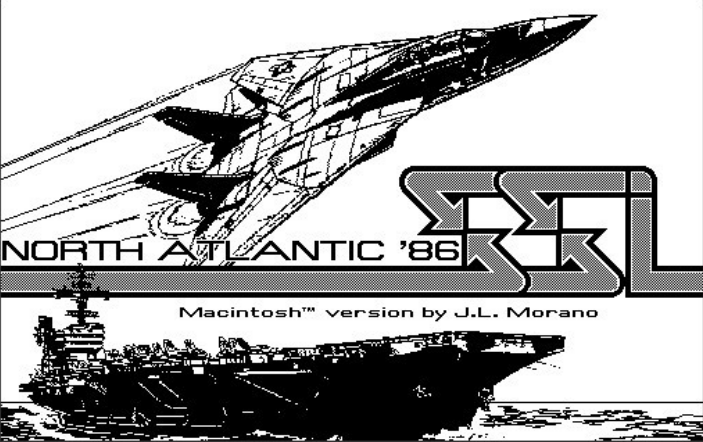
North Atlantic ’86 by Gary Grigsby, published by SSI
First release : April 1983 on Apple II
Tested on : Apple emulator
Total time tested : 15 hours
Average duration of a campaign (using an Emulator that massively accelerates the game)
12 hours (short campaign)
20 hours (estimated, long campaign)
Complexity: High (3/5)
Would recommend to a modern player : No
Would recommend to a designer : No
Final Rating : Obsolete
Ranking at the time of review : 21/66
This review assumes you have read the AAR : Early November, Late November, Finale
Gary Grigsby’s North Atlantic ’86 was the last game to use the Guadalcanal Campaign engine. Guadalcanal Campaign had limited success (4650 sales), but found a huge fan in Joel Billings who immediately greenlighted Bomb Alley. Bomb Alley, on the other hand, had been a commercial disaster (2082 copies), but given how games were produced before the digital age, as Joel Billings recalls in an email, “North Atlantic ’86 was probably done and out by the time we figured out Bomb Alley wasn’t selling“. In any case, being the founder and CEO of a video game company has its perks, and Joel Billings adds: “we probably would have done it even if we had known”.
Grigsby had started working on North Atlantic ’86 while Bomb Alley was still under SSI internal test. He had a keen interest in modern naval warfare, and wanted to do something different without changing his engine. Coincidently, the Falkland War had ended less than one year prior, giving the world a taste of what modern naval warfare would look like. Using Combat Fleets of the World 1982-1983 and a boardgame whose name he forgot as his main sources, Grigsby converted his WW2 game into a cold-war-gone-hot game.
North Atlantic ’86 was sold in the same way as Grigsby’s previous games : for 59.95 USD you could have the game, a manual and a reference card with the map on one side and a pretty packed sheet of data on the other side. The game received at least one revision : the first version had a bug (which happened to me) where the Faroe Islands’ airbase is, according to the code, one tile to the right to its port. Unfortunately, that tile is a land tile, so the base can only be attacked or supplied by air assault and the port is totally useless.
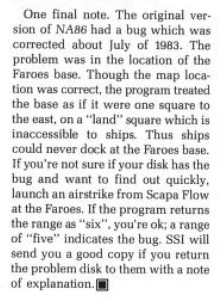
North Atlantic ’86 is one of the very few SSI games to receive a MacIntosh version. Like the other SSI MacIntosh ports, this conversion was done by an outside developer (in this case J.L.Morano) on their initiative. The port is very competent and makes good use of the MacIntosh’s specificities : native mouse and drop-down menus.
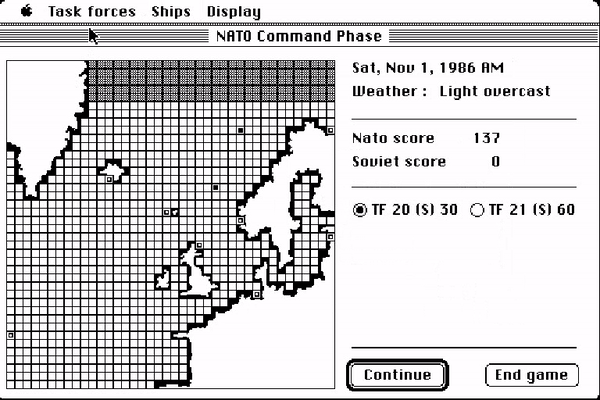
The game also plays much faster, for instance only providing end results to air combat (“6 Tornadoes destroyed”) rather than a detailed account of the fate of each individual missile or each individual attack. For these reasons, the game feels different despite using the same ruleset.
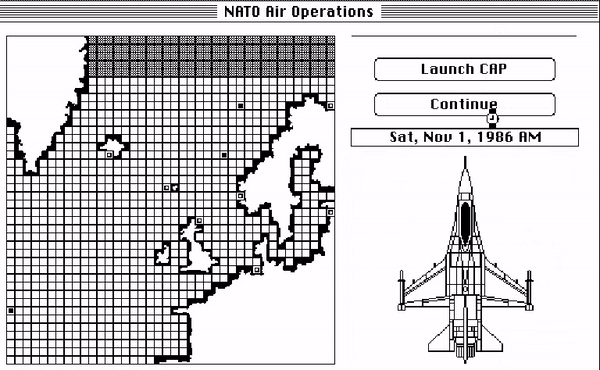
Except when indicated otherwise, I will only discuss the original Apple II version in my review.
Final note : I was curious why SSI did not make North Atlantic ’86 happen in the same alternative history as Roger Keating’s 1985 series ; I asked Billings and his answer was that… it simply didn’t occur to them to do so.
A. Immersion
I won’t discuss the backstory again. It is good that it exists and it created a healthy discussion in the first North Atlantic ’86 post, I will just state that Grigsby had to find a rationale to remove the French fleet without letting the Soviets use ports in Britany. On the other hand, the backstory does not explain why the Americans only allocate 4 of their 13 or so carriers to the North Atlantic; we can suppose the other carriers are busy in the Pacific or the Mediterranean but of course, we all know the real reason is “balancing”. As for the Soviets, they allocated their best ships to the Atlantic : the two Kiev-class carrier-cruisers and their two Kirov-class nuclear cruisers.
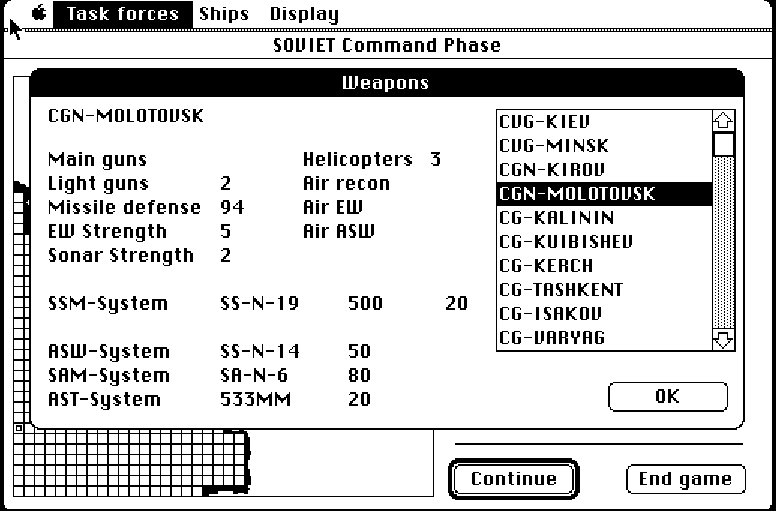
The only key ships the Soviets are missing are their two Moskva-class helicopter cruisers, possibly because the game engine could not make them shine. Indeed, on the NATO side, the closest equivalent to the Soviet helicopter cruisers are the Iwo Jima-class Landing Platform Helicopter (LPH) or the Tarawa-class Landing Helicopter Assault (LHA) – these are in the game… as glorified transport ships with good air defence and no helicopter after all. Sad.
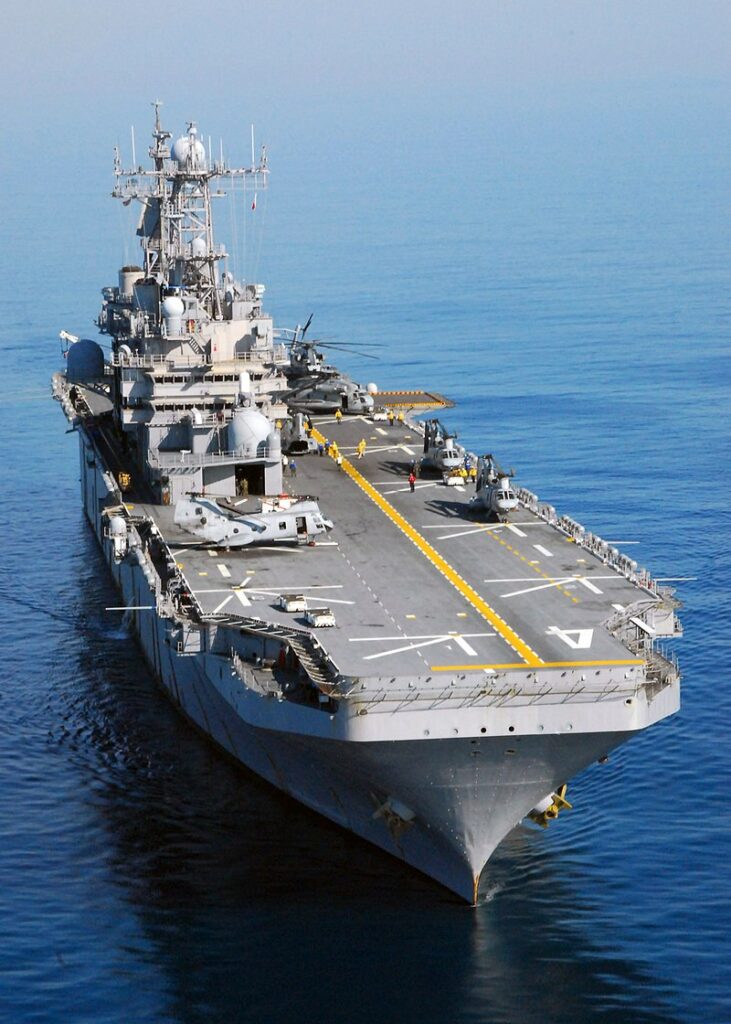
“Hmm… the only use I can see is supply storage.”
The game abounds in the kind of technical details that make it feel realistic at first glance : each ship and each plane has its own stats, even for stuff you will never use, there is a wide variety of equipment, complex interception rules, etc. Not all of it is useful, but it is immersive.

Unfortunately, the technical realism quickly feels hollow – the game does not play right compared to what modern naval warfare would probably be (not that we know, luckily). In particular, it feels like planes are teleporting from their airbases (or carriers) to their targets as they can only be intercepted by other planes patrolling above their targets, never on the way. As a matter of example, Soviet bombers taking off from Hamburg can fly over UK to strike a fleet near Iceland without triggering any early warning ; there is no way to intercept them with planes from Scapa Flow, or to tell the Tomcats protecting their targets to get into position to shoot them down. Consequently, anti-ship bombers are almost impossible to intercept, with only a handful shot down every attack even though the Tomcat was designed to intercept and destroy those bombers. There is no way to intercept supply planes or reconnaissance aircrafts either. The end result is that the game is not about having planes and radars in key locations to detect and intercept enemy bombers, but about managing the attrition of ships that cannot be avoided and praying for the missiles to go after the cruisers and the destroyers rather than after the carriers. The game is clearly immersive, but less so than say Bomb Alley as it fails in being a realistic simulation.
Rating : Quite good
B. UI , Clarity of rules and outcomes
The manual is as clear as it was for the earlier games, but the Guadalcanal Campaign‘s engine is stretched out, and it shows. In particular, the stats for the ships are spread out in two menus, with some now-useless information (main guns) in the most accessible menu while the missile line-up is hidden in a new “Weapon System” menu. The missile line-up is also totally absent from the manual, so as a player you have no idea about the range of the enemy systems. Worse, the missile line-up only shows the current situation, and there is no way to know the maximum allotment for a given ship :
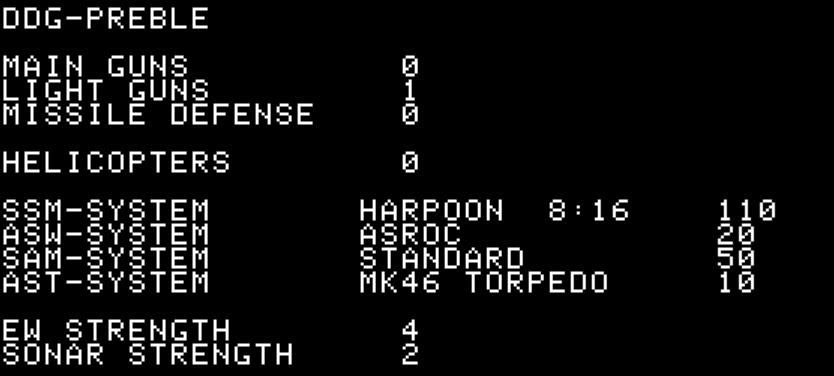
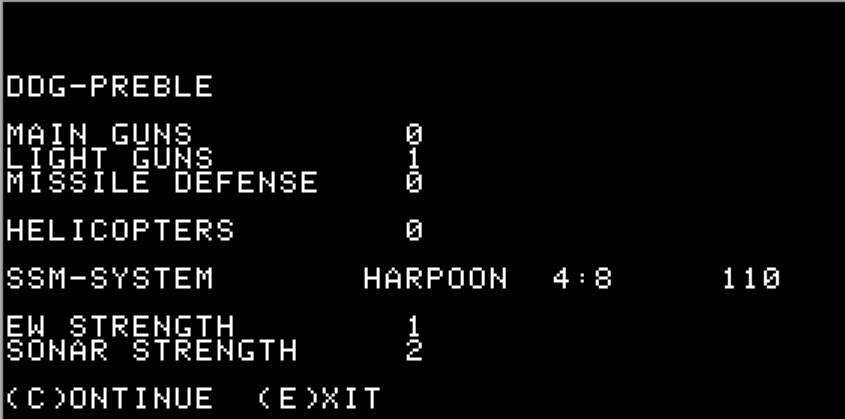
It makes it hard to know when to send your ships to reload, especially for your submarines whose only purpose is to attack the enemy.
Still, and though there are other minor issues like this one, I can’t deny Grigsby managed to make – relatively – understandable a game with complex rules, so hats off to him.
Rating : Quite good
C. Systems
North Atlantic ’86 looks like the two earlier games, but of course a lot has changed. To start with, the reconnaissance missions are now automatically launched so no need to detach bombers from a future strike force – a logical design decision as the 80s had dedicated reconnaissance aircrafts (3 different types in the game). Unfortunately, as I said earlier, those recon assets cannot be shot down ; they are also “free”, long-range (20 tiles for one of them) and numerous in airbases (12 in Bergen, 12 in Hamburg for the long-range reconnaissance planes alone), so when the weather is clear it is almost impossible to avoid detection. The chance of being detected goes down by 1/3 in “light overcast” and 2/3 in “heavy overcast”, but weather can change every turn, so it is hard to build up a strategy around avoiding detection – at best you can hope to avoid one or two turns of attack – if and only if you took the risk of turning your electronic warfare systems off.
Electronic Warfare is another innovation of North Atlantic ’86. Having it active makes a fleet automatically detected, but leaving it inactive leaves a fleet particularly vulnerable : if the Early Warning aircrafts (yet another innovation on which the player has no leverage) don’t spot an incoming attack force, then neither the SAM nor the interceptors will be able to neutralize the enemy missiles as they approach. In practice, I found that turning the EW off is not worth the risk, except when the weather is terrible and the Soviet bases are far away.
So what’s left for the player to decide ?
- The “organisational” decisions : which ships for which task forces, and where to allocate the planes and supplies,
- The fleet movement,
- How many fighters are allocated to
- normal combat air patrol (CAP), protecting only their airbase or their carrier group, even if another allied fleet is on the same tile
- long-range CAP, protecting all ships in range, but much less efficiently,
In addition, normal CAP will only intercept missiles and direct bombers (the Fencers) while long-range CAP will also try to intercept the missile-launching planes (Badgers and Backfires),
- What targets the strike forces should have – but as was showcased in my AAR there is rarely more than one target to choose from,
- Finally, at which distance from their targets attacking planes should launch their missiles (“stand-off range”) – long stand-off ranges are safe but inaccurate, short stand-off ranges put you within the anti-air envelope of your target ; of course the optimum is almost always “launch missiles from 1 km farther than the maximum range of what the other side has“,
That’s not many decisions to take, especially when each turn takes a minimum of 5 minutes to play if there is any fleet to manage at maximum emulator speed ; at historical speed it could take up to one hour. Once you have created a task force and decided on a route, your only real decision every turn is you want to allocate planes between normal CAP and long-range CAP. Sadly, this is an artificial decision ported from the earlier games’ WW2 context ; in reality interceptors are not going to refuse to wait for the enemy planes to launch their missiles or refuse to try to destroy those missiles because those missiles are not aimed at the carrier group.
Rating : Acceptable.
D. Scenario design and balancing
North Atlantic ’86 is shipped with 4 scenarios ; the two short ones (a convoy to Scapa Flow and a NATO attempt to recapture Iceland) can be considered tutorials.
This leaves the two long ones (September to December and November – December). Unfortunately, the scenarios do not leverage the strengths of the engine. As per reality, the Soviets have only two carriers, and as per reality the only planes those carriers can launch are very short-range fighters than can’t intercept missiles, nor even the A6E Intruders launching said missiles. The rest of the Soviet fleet is small and unable to be a threat to NATO’s fleets – not much Grigsby could do about that either, the Soviet fleet never matched the American one. This leaves the land-bound planes, and indeed they are a threat, but it also turns North Atlantic ’86 into a tower defence game where you are playing OpFor. Not great.
Rating : Average.
E. Did I make interesting decisions ?
Not enough for the time invested.
F. Final rating
Obsolete. At its release, North Atlantic ’86 was the most detailed computer wargame about modern warfare, if not the most detailed computer wargame full stop. It is certainly better than Guadalcanal Campaign which was turn after turn of doing nothing, but the engine is too slow and more importantly too limited for modern warfare. It cannot measure up to Bomb Alley, which had a very exciting first month and the courtesy to allow you to end the game soon after that by taking Alexandria.
,
Contemporary Reviews
North Atlantic ’86 had everything to please Computer Gaming World, and without surprise the game received a full-fledged “Review and Strategy” article in December 1983. Interestingly for me, Jay Selover played the full campaign and he described the harrowing beginning of the game for NATO :
The real test is to show the will to keep playing through the lean times. […] In the first weeks, the Faroes will fall, Scapa Flow will be bombed unmercifully, NATO morale will begin to drop, and naval losses will be high. It’s difficult as a new player to avoid the conclusion that you’re just incompetent as a commander, but stick with it; it’s not over until it’s over!
Selover’s final opinion on the game is very positive, with a warning : “It definitely should not be your first computer wargame. But it definitely should be one of your wargames“. Amusingly, Creative Computing in September 1984 disagrees with Selover ; not on the quality of the game (“biggest wargame for home computer to date“) but on its complexity for a beginner : “The game should have appeal for veteran wargamers, who will find it a challenging test of their skills, and for first-time wargamers, who will find it surprisingly easy to learn.
Softtalk takes the middle ground, calling the game “highly detailed, yet playable” in September 1983, while InCider warns in March 1984 : “War gamers – but war gamers only – will flip over North Atlantic ’86” as the game “plays itself” during long turns.
North Atlantic ’86 sold 7 772 copies in the United States (including around 1600 for MacIntosh), more than Guadalcanal Campaign and Bomb Alley combined. But before North Atlantic ’86 had even hit the shelves, Grigsby had started working on his next game, this one using hexagons on the advice of Joel Billings : Carrier Force.